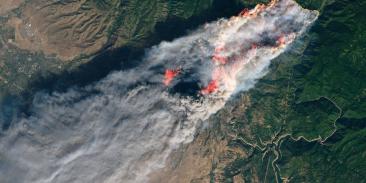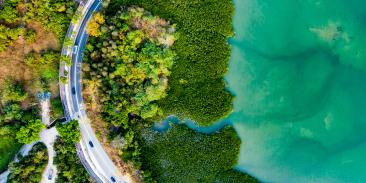Climate Change Makes River Restoration More Important than Ever, Paper Concludes
FOR IMMEDIATE RELEASE
Contact:
Stacy Small, PhD, Conservation Scientist, Center for Conservation Incentives, Environmental Defense Fund, (202) 572-3263, ssmall@edf.org
Climate Change Makes River Restoration More Important than Ever, Paper Concludes
(Washington, DC – September 1, 2009) Restoring river ecosystems and riparian corridors can play an important role in combating climate change impacts to ecosystems by connecting one area to another, enabling plants and animals to move as the climate shifts. It also will create places that shelter fish and wildlife from hotter temperatures, which ecologists call “thermal refugia.”
Those are among the conclusions of a new peer-reviewed paper by seven organizations that evaluated how protecting and restoring river ecosystems and riparian areas can enhance the ability of these ecosystems to cope with climate change. This work appears in the September issue of Ecological Restoration (http://er.uwpress.org/cgi/reprint/27/3/330) with a collection of articles dedicated to the theme of restoration and climate change. In the paper, the scientists discuss the importance of replanting riparian vegetation and ensuring that rivers have sufficient water to maintain flows that benefit birds, fish and other wildlife, and human communities. Based on these and other benefits of riparian restoration, the authors recommend that river restoration activities continue and expand as the climate changes.
“I often hear people ask: ‘if climate change is going to disrupt natural systems, why should we bother to restore them?’” explains Nat Seavy, terrestrial research director at PRBO Conservation Science. “Restoration, especially of riparian areas, is a critical step toward protecting the integrity of ecosystems and the benefits they provide – including clean water, pollination, and flood protection – to wildlife and humans in a time of rapid climate change.”
The authors also discuss the need to modify restoration strategies to prepare for the uncertain conditions predicted to accompany climate change, and for ongoing research and monitoring to evaluate and improve restoration practices. Recommendations include planting a mix of riparian plants that are both drought and flood tolerant, ensuring that rivers have sufficient water to provide for periodic flooding of natural areas, and increasing habitat restoration on private lands.
“Protecting genetic diversity and native biodiversity with restoration projects will boost the resilience of society and nature to potentially catastrophic climate change impacts,” says paper co-author Stacy Small, conservation scientist with Environmental Defense Fund’s Center for Conservation Incentives. “Working with landowners to restore private lands will also enhance restoration efforts on adjacent public lands.”
For decades, conservationists have been aware that increasing human populations, development, and changing land use threaten biodiversity and ecosystem services. Ecological restoration was originally developed to help speed the recovery of landscapes disrupted by human activities. Today, there is a growing awareness that ecological restoration also must look ahead to consider the potential consequences of a changing climate.
“Because dams and water diversions have disrupted natural water regimes, simply protecting the river isn’t enough,” explains Thomas Griggs, senior restoration ecologist with River Partners, an organization that has led restoration efforts along the Sacramento and San Joaquin Rivers. “Over the last 20 years, we’ve learned how to speed the return of birds and other wildlife to these important habitats by planting the vegetation that would have come back as a result of natural flooding. In the next 20 years, we will need to look ahead to understand how climate change will impact these systems, and ensure that our efforts are successful into the future.”
Working collaboratively with partners across disciplines is increasingly important for effective restoration. The authors that collaborated on this project work for government agencies (the United States Department of the Interior’s Bureau of Land Management), academic institutions (University at California Davis), and non-profit organizations (PRBO Conservation Science, The Nature Conservancy, Audubon California, Environmental Defense Fund, and River Partners).
“This paper exemplifies the importance of partnering to prepare for climate change,” explains Ellie Cohen, executive director of PRBO Conservation Science. “By building diverse teams with unique knowledge and on-the-ground experience we can develop practical solutions supported by sound science.”
Authors were Nathaniel Seavy, Thomas Gardali, and Christine Howell (PRBO Conservation Science), Gregory Golet (The Nature Conservancy), Thomas Griggs (River Partners), Rodd Kelsey (Audubon California), Stacy Small (Environmental Defense Fund), Joshua Viers (UC Davis), and James Weigand (Bureau of Land Management).
###
PRBO Conservation Science is a non-profit conservation and education organization dedicated to advancing conservation through birds and ecosystem research. Founded in 1965 as Point Reyes Bird Observatory, PRBO Conservation Science partners with hundreds of governmental and non-governmental agencies as well as private interests to ensure that every dollar invested in conservation yields the most for biodiversity — benefiting our environment, our economy, and our communities. Visit PRBO on the web at www.prbo.org.
Environmental Defense Fund is a national nonprofit organization that links science, economics, law and innovative private-sector partnerships to create breakthrough solutions to the most serious environmental problems. EDF’s Center for Conservation Incentives (CCI) is an initiative to develop and expand landowner incentives for the conservation of natural resources and rare plants and animals. For more information visit: www.edf.org. Contact: Stacy Small, PhD, Conservation Scientist, (202)572-3263, ssmall@edf.org
Audubon California is building a better future for California by bringing people together to appreciate, enjoy and protect our spectacular outdoor treasures. Audubon California is a field program of Audubon, which has more than 50,000 members in California and an affiliated 48 local chapters dedicated to protecting birds, wildlife and the habitats that support them. Visit Audubon California on the web at www.ca.audubon.org.
Over the last 11 years, River Partners has restored more than 6,000 acres of river banks and floodplains, providing critical habitat for wildlife and sustainable solutions for California’s rivers. Its habitat restoration work supports efforts to sequester greenhouse gases, improve water and air quality, recover endangered species, improve public safety, and protect open space. A nonprofit organization, River Partners’ mission is to create wildlife habitat for the benefit of people and the environment.
The Nature Conservancy is a leading conservation organization working around the world to protect ecologically important lands and waters for nature and people. To date, the Conservancy and its more than one million members have been responsible for the protection of more than 18 million acres in the United States and have helped preserve more than 117 million acres in Latin America, the Caribbean, Asia and the Pacific. Visit The Nature Conservancy on the Web at www.nature.org.
The Bureau of Land Management (BLM) manages more land - 256 million acres - than any other Federal agency. About 15 million acres are in California and comprise some of the most biologically diverse areas in the State. These public lands, officially known as the National System of Public Lands, stretch from the Sierra to the Pacific and from northern ancient forests to southern desert expanses. BLM’s multiple-use mission is to sustain the health and productivity of the public lands for the use and enjoyment of present and future generations.
This work was funded in part by the CALFED Science Fellows Program. Beginning with the class of 2003, the CALFED Science Fellows Program has paired graduate students and postdoctoral researchers with CALFED Program agency scientists and senior research mentors. Fellows work on collaborative data analysis and research projects applicable to the California Bay-Delta system.
Citation
Seavy, N. E., T. Gardali, G. H. Golet, F. T. Griggs, C. A. Howell, R. Kelsey, S. Small, J. H. Viers, J. F. Weigand. 2009. Why climate change makes riparian restoration more important than ever: Recommendations for Practice and Research. Ecological Restoration 27:330-338. (open access available at: http://er.uwpress.org/cgi/reprint/27/3/330)
With more than 3 million members, Environmental Defense Fund creates transformational solutions to the most serious environmental problems. To do so, EDF links science, economics, law, and innovative private-sector partnerships to turn solutions into action. edf.org
Latest press releases
-
Court Strikes Down Trump Administration’s Reckless Wind Energy Permitting Ban
December 8, 2025 -
Court Orders Trump Administration to Release Records of Secret Group That Wrote Report Attacking Climate Science
December 8, 2025 -
COMING SOON: An effort to weaken our popular chemical safety law
December 8, 2025 -
Groups File Lawsuit Challenging Trump EPA Final Rule That Delays Methane Pollution Protections from Oil and Gas Industry
December 4, 2025 -
New Statewide Survey: As Electricity Demand and Costs Skyrocket, Arizonans Support Building More Wind and Solar Energy
December 4, 2025 -
Trump Administration Announces Plan to Weaken Fuel Economy Standards for Cars and Trucks
December 3, 2025










